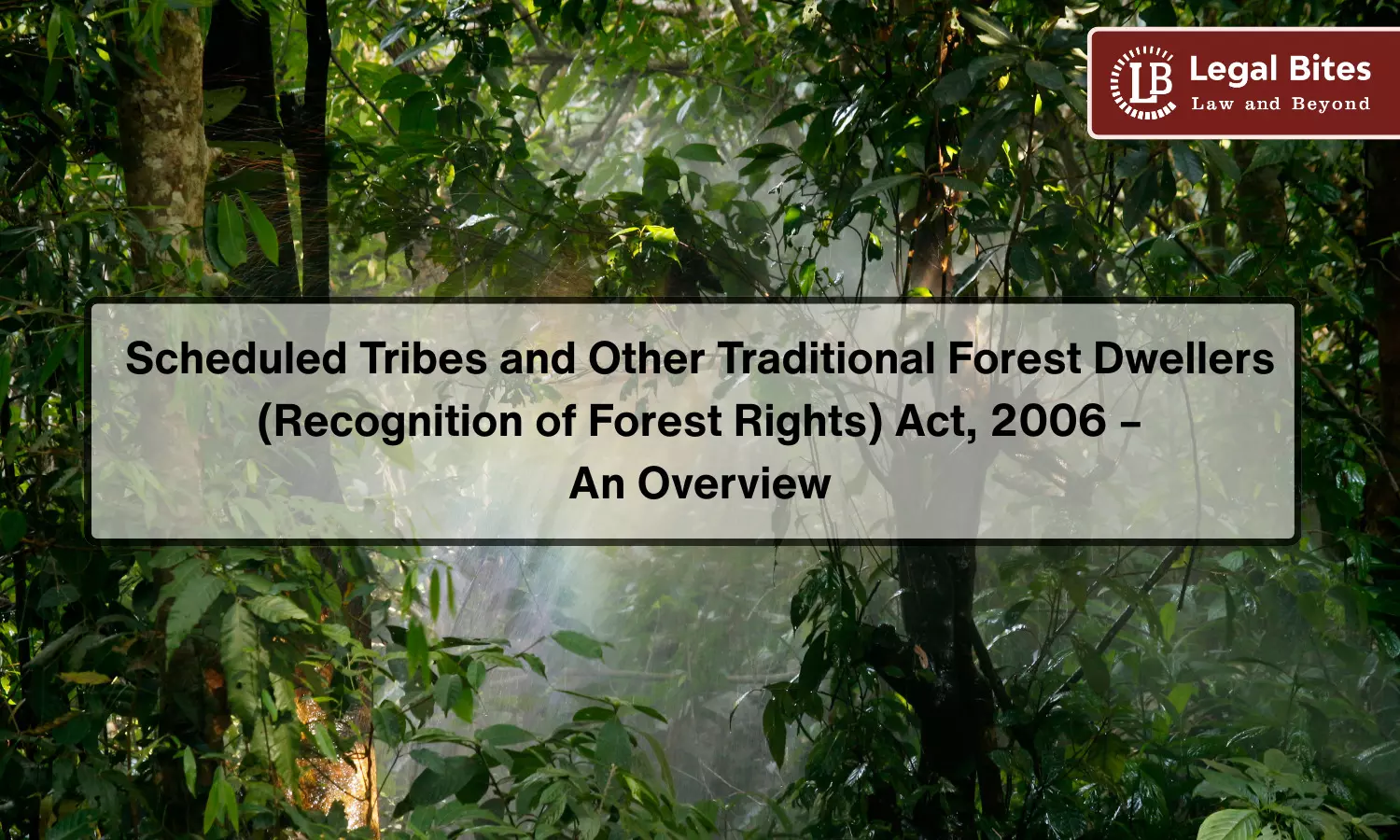Scheduled Tribes and Other Traditional Forest Dwellers (Recognition of Forest Rights) Act, 2006 – An Overview
The Forest Rights Act, 2006 grants forest land and resource rights to STs and forest dwellers, addressing historical injustices and securing their livelihoods.

India’s forests have long been home to diverse communities, especially Scheduled Tribes (STs) and other traditional forest dwellers (OTFDs), whose lives and livelihoods are intricately tied to the forests they inhabit. However, for decades, these communities were denied legal recognition of their rights, often facing displacement and marginalisation. The Scheduled Tribes and Other Traditional Forest Dwellers (Recognition of Forest Rights) Act, 2006—commonly referred to as the Forest Rights Act (FRA)—was enacted to address these historical injustices. This article critically analyses the FRA, its objectives, provisions, implementation challenges, and its broader socio-legal implications.
Objectives of the Forest Rights Act, 2006
The primary objectives of the FRA are:
- To recognise and vest forest rights in forest-dwelling Scheduled Tribes and OTFDs who have been residing in forest land for generations but lack legal documentation.
- To establish responsibilities for sustainable forest use and conservation among local communities.
- To correct the injustice caused by forest laws that ignored the traditional rights of forest communities.
The Act acknowledges the role of tribal and forest-dwelling communities as conservers of forests and biodiversity.
Key Definitions under the Act
- Scheduled Tribes (STs): As defined under Article 342 of the Constitution of India.
Article 342 in the Constitution of India:
(1) The President may with respect to any State or Union territory, and where it is a State after consultation with the Governor thereof, by public notificationspecify the tribes or tribal communities or parts of or groups within tribes or tribal communities which shall for the purposes of this Constitution be deemed to be Scheduled Tribes in relation to that State or Union territory, as the case may be.
(2) Parliament may by law include in or exclude from the list of Scheduled Tribes specified in a notification issued under clause (1) any tribe or tribal community or part of or group within any tribe or tribal community, but save as aforesaid a notification issued under the said clause shall not be varied by any subsequent notification.
- Other Traditional Forest Dwellers (OTFDs): Communities who have resided in the forests for at least three generations (75 years) prior to 13 December 2005 and depend on forest land for their livelihood.
- Forest Rights: Includes rights to live in forest land under individual or community tenure, cultivate land, use minor forest produce, protect and conserve forest areas, and access traditional seasonal resources.
Types of Forest Rights Recognised
Under Section 3 of the FRA, a range of rights is recognised:
Title Rights: Legal recognition of land ownership for those occupying forest land before 13 December 2005.
Use Rights:
- Collection and use of Minor Forest Produce (MFP) like tendu leaves, honey, bamboo, etc.
- Grazing rights and access to water resources.
Relief and Development Rights:
- Rehabilitation in case of illegal eviction or forced displacement.
- Rights to basic facilities like education, health, and electricity.
Forest Management Rights:
- Community rights to conserve, regenerate, and manage forests.
- Recognition of traditional knowledge and cultural practices.
Eligibility and Evidence Requirements
Eligibility is based on:
For STs: Proof of residing in forest land and depending on it for a livelihood as of 13 December 2005.
For OTFDs: In addition to the above, proof of 75 years’ residence.
Evidence can include:
Government records, affidavits, satellite images, maps, oral evidence, community testimonies, etc., as per Rule 13 of the FRA Rules, 2008 (amended in 2012).
Institutional Mechanism for Claim Processing
The FRA establishes a three-tier structure for recognising rights:
- Gram Sabha (Village Assembly) – Initiates the process, receives claims, verifies and passes resolutions.
- Sub-Divisional Level Committee (SDLC) – Reviews Gram Sabha decisions and forwards recommendations.
- District Level Committee (DLC) – Final authority to approve or reject claims.
This decentralised process aims to empower local communities and uphold principles of participatory democracy.
Role of Gram Sabha
Under Section 6, the Gram Sabha plays a central role:
- Determines the nature and extent of individual and community forest rights.
- Responsible for the protection of wildlife, forest biodiversity, and traditional knowledge.
- Regulates access to forest resources.
Land Ceiling and Restrictions
- Individual land rights under FRA are limited to a maximum of 4 hectares.
- The land should have been under occupation before the cut-off date (13 December 2005).
- The title granted is heritable but not alienable, ensuring it remains within the community.
Critical Judicial Intervention
Orissa Mining Corporation v. Ministry of Environment and Forest (2013)
The Supreme Court addressed the legality of denying Stage-II forest clearance for bauxite mining in the Niyamgiri Hills by Orissa Mining Corporation (OMC) and Sterlite Industries. The Court upheld the rights of Scheduled Tribes (STs) and Other Traditional Forest Dwellers (OTFDs), particularly the Dongaria Kondh community, under the Forest Rights Act, 2006 and emphasised their right to protect religious and cultural practices. It held that the Gram Sabha was the competent authority to determine community, cultural, and religious claims, including worship rights at Niyam-Raja hilltop.
The Court directed fresh Gram Sabha consultations supervised by a judicial officer and held that no clearance could be granted without determining these rights. The judgment underscored the primacy of tribal rights in forest governance and reinforced the legal and constitutional framework protecting indigenous communities.
Implementation Challenges
Despite its transformative potential, the FRA faces several obstacles:
- High Rejection Rates: Over 50% of claims have been rejected, often without proper reasons or Gram Sabha involvement.
- Lack of Awareness: Many forest dwellers are unaware of their rights or lack documents to prove eligibility.
- Resistance from Forest Departments: Bureaucratic resistance and continued control over forest land hinder decentralisation.
- Delayed Land Titles: Even approved claims take years to translate into land titles, especially for community forest rights.
- Judicial Ambiguity: Courts have often balanced conservation with tribal rights, sometimes leaning toward ecological protection without adequate recognition of FRA mandates.
Success Stories and Grassroots Impact
1. Mendha Lekha (Maharashtra):
The first village to receive community forest rights in 2009.
The villagers collectively manage bamboo harvesting and forest conservation.
2. Niyamgiri (Odisha):
The Dongria Kondh tribe successfully opposed bauxite mining through Gram Sabha decisions under FRA.
3. Jharkhand and Chhattisgarh:
Several tribal communities now receive revenue from MFP collection and sustainable forest management.
Recent Developments and Policy Concerns
Compensatory Afforestation: Questions have been raised about afforestation programs implemented on lands with pending FRA claims.
Draft Forest Policy 2018 and Van (Sanrakshan Evam Samvardhan) Adhiniyam, 2023: These raise concerns about forest governance shifting away from community-based models.
The Ministry of Tribal Affairs, as the nodal authority for the FRA, has issued guidelines to strengthen implementation, yet on-ground progress remains uneven.
Recommendations for Effective Implementation
- Capacity Building: Training local communities, especially women, on rights and procedures.
- Proactive Role of State Governments: Avoiding bureaucratic delay and ensuring coordination between the tribal and forest departments.
- Clear Rejection Reasons: Rejected claims should involve proper hearings, legal aid, and the right to appeal.
- Digitisation and Mapping: Use of GIS tools to demarcate forest land claimed under the FRA.
- Monitoring and Review: Regular audits by independent bodies to ensure transparency.
Conclusion
The Forest Rights Act, 2006 represents a landmark shift in India’s forest governance framework, moving from exclusionary conservation to community-centric forest rights. By recognising the deep relationship between forest communities and their environment, the Act not only seeks to correct historical wrongs but also promotes sustainable and inclusive development.
Yet, implementation remains a work in progress. Unless the procedural and institutional roadblocks are addressed and community participation is genuinely encouraged, the transformative promise of the FRA may remain unfulfilled. Empowering forest dwellers through effective implementation of this Act is not just a statutory obligation but a constitutional and moral imperative for a just and equitable society.
References
[1] Scheduled Tribes and Other Traditional Forest Dwellers (Recognition of Forest Rights) Act, 2006.
[2] Forest Rights Rules, 2008 and 2012 (Amendment).
[3] Orissa Mining Corporation v. Ministry of Environment & Forests, (2013) 6 SCC 476.
[4] Statement on the Saxena Committee Report on the Forest Rights Act, Available Here
Important Link
Law Library: Notes and Study Material for LLB, LLM, Judiciary, and Entrance Exams

